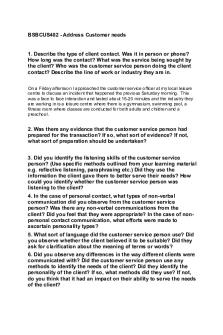Bsbcus 402 address customer needs jhhkjjhvcvxzd jkhkjkj hjhkj jjk jkhn nhkjftydtrcghvnbmnbvvghcfgdxvvbnbjhgg.bn PDF

| Title | Bsbcus 402 address customer needs jhhkjjhvcvxzd jkhkjkj hjhkj jjk jkhn nhkjftydtrcghvnbmnbvvghcfgdxvvbnbjhgg.bn |
|---|---|
| Course | Certificate Iv in Health Administration |
| Institution | TAFE New South Wales |
| Pages | 2 |
| File Size | 53.3 KB |
| File Type | |
| Total Downloads | 16 |
| Total Views | 138 |
Summary
address customer needs jhhkjjhvcvxzd jkhkjkj hjhkj jjk jkhn nhkjftydtrcghvnbmnbvvghcfgdxvvbnbjhgg.bn...
Description
BSBCUS402 - Address Customer needs
1. Describe the type of client contact. Was it in person or phone? How long was the contact? What was the service being sought by the client? Who was the customer service person doing the client contact? Describe the line of work or industry they are in. On a Friday afternoon I approached the customer service officer at my local leisure centre to discuss an incident that happened the previous Saturday morning. This was a face to face interaction and lasted about 15-20 minutes and the industry they are working in is a leisure centre where there is a gymnasium, swimming pool, a fitness room where classes are conducted for both adults and children and a preschool.
2. Was there any evidence that the customer service person had prepared for the transaction? If so, what sort of evidence? If not, what sort of preparation should be undertaken? 3. Did you identify the listening skills of the customer service person? (Use specific methods outlined from your learning material e.g. reflective listening, paraphrasing etc.) Did they use the information the client gave them to better serve their needs? How could you identify whether the customer service person was listening to the client? 4. In the case of personal contact, what types of non-verbal communication did you observe from the customer service person? Was there any non-verbal communications from the client? Did you feel that they were appropriate? In the case of nonpersonal contact communication, what efforts were made to ascertain personality types? 5. What sort of language did the customer service person use? Did you observe whether the client believed it to be suitable? Did they ask for clarification about the meaning of terms or words? 6. Did you observe any differences in the way different clients were communicated with? Did the customer service person use any methods to identify the needs of the client? Did they identify the personality of the client? If so, what methods did they use? If not, do you think that it had an impact on their ability to serve the needs of the client?
7. Was there any conflict between the customer service person and the client? If so how was it handled? Did you think that the customer service person was able to understand the needs of the client? What tools and techniques did they use to express their empathy with the needs of the client? 8. Did the customer service person doing the client contact identify boundaries of the client contact? Did they stay within those boundaries? (Include issues of how comfortable the client allowed the customer service person into their personal space and cultural factors that may prohibit proximity.) 9. What types of information were given to the client by the customer service person? Was the information appropriate? Did it assist the client with identifying their own needs? If so, how did it assist the client to make a better decision? If not, what types of information should have been provided to the client? 10. Do you think the client had their needs satisfied? If so, what were those needs and how were they satisfied? If not, what could the customer service person have done to better identify and then satisfy those client needs? 11. What methods were used by the customer service person to develop an on-going relationship with the client? If not, can you recommend some strategies the organisation might use to develop an on-going relationship with a client? 12. Overall, how might the organisation/workplace improve its communications with its client? Make some general suggestions for improvement....
Similar Free PDFs

Bsbcus 402 Assesment 2
- 15 Pages

Bsbcus 402 Assessment 1
- 6 Pages

Bsbcus 501C AT3 Project
- 9 Pages

Bsbcus 301 Assessment
- 8 Pages

Bsbcus 501 - Hong Nhung Duong
- 30 Pages

Assessment 1 Bsbcus 501
- 7 Pages

Assessment - Bsbcus 403
- 9 Pages

Budgeting and Scheduling 402
- 7 Pages

NIA 402 - Resumen
- 9 Pages

402-IT Class X
- 212 Pages

NEEDS ANALYSIS.pptx
- 39 Pages

Bsbitu 402- Task3 2
- 2 Pages
Popular Institutions
- Tinajero National High School - Annex
- Politeknik Caltex Riau
- Yokohama City University
- SGT University
- University of Al-Qadisiyah
- Divine Word College of Vigan
- Techniek College Rotterdam
- Universidade de Santiago
- Universiti Teknologi MARA Cawangan Johor Kampus Pasir Gudang
- Poltekkes Kemenkes Yogyakarta
- Baguio City National High School
- Colegio san marcos
- preparatoria uno
- Centro de Bachillerato Tecnológico Industrial y de Servicios No. 107
- Dalian Maritime University
- Quang Trung Secondary School
- Colegio Tecnológico en Informática
- Corporación Regional de Educación Superior
- Grupo CEDVA
- Dar Al Uloom University
- Centro de Estudios Preuniversitarios de la Universidad Nacional de Ingeniería
- 上智大学
- Aakash International School, Nuna Majara
- San Felipe Neri Catholic School
- Kang Chiao International School - New Taipei City
- Misamis Occidental National High School
- Institución Educativa Escuela Normal Juan Ladrilleros
- Kolehiyo ng Pantukan
- Batanes State College
- Instituto Continental
- Sekolah Menengah Kejuruan Kesehatan Kaltara (Tarakan)
- Colegio de La Inmaculada Concepcion - Cebu



